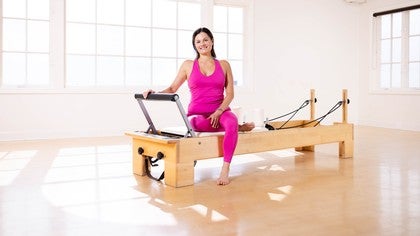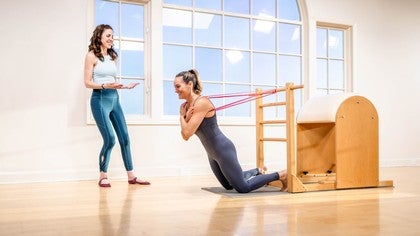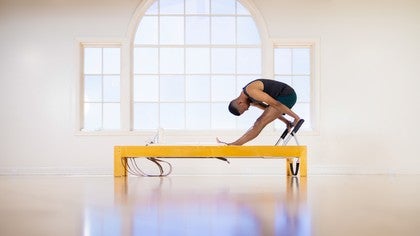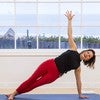Tutorial #5522
Choosing the Right Spring For You
Description
Please Note: In this tutorial, it is mentioned that the yellow spring is the heaviest spring on Peak Pilates equipment. However, we would like to make a correction, as the red spring is the heaviest spring available on the Peak Pilates Reformer.
About This Video
Transcript
Read Full Transcript
Let's talk about springs. So often people are a little unsure of how to deal with the springs and and and which springs to use when that question comes up a lot. So I'm here today to kinda help you learn a little more about the springs on various different pieces of equipment. So hopefully you feel a little bit more comfortable choosing the right spring in various different exercises. 1st and foremost, it's important to recognize that All of the springs are a little bit different. Even if you have 2 different, 2 balanced body reformers with same spring low depending on their use and when they were made and whatnot, it might be just a little bit different.
So anything that I suggest is simply a guide, and it's really important that you get to know and understand the piece of equipment that you're working with. Also know that each maker has slightly different springs. In the old days, we didn't have color coded. Springs. They were all just, plain silver or whatever color. And so you just had to know your springs to know what they were.
Nowadays, we have these really lovely color coded springs, but each maker has different color coding. So What I'd like to teach you today is a bit of a guide on the springs that we use here in the studio and then how to use that to assess what your springs may, how your springs may work for you. Okay? So balance body equipment is what I'm on here, and we've got On the reformers, we have got option for a green spring. We've got option for a red spring. We've got option for a blue spring, and we've got option for a yellow spring. And for instance, peak equipment, the yellow spring is the heaviest spring.
Balance body, the yellow spring is the lightest spring. So it's important to be able to look at your springs and understand how they're different. So this green spring, which is the heaviest spring, you see if I wiggle it around a little bit, it doesn't really bend very much where the the the yellow one does. You also wanna look a little bit at the difference between the two coils. The green spring has a much thicker coil, and it's a thicker spring where the yellow spring has a much smaller coil.
It's a smaller spring. So for this piece of equipment, for balanced body, the green spring is the heaviest spring, and I like to consider it a a little more than a full spring, so almost a spring and a quarter. The red spring is what we consider kind of a full spring. You know, you can change it however you like in your view, but usually we have more red springs. So we consider that a full spring.
The blue spring is half of the red about, and then the yellow is half of the blue. Okay? So When choosing the springs, either to order for your piece of equipment or to use on your piece of equipment, it's really useful to understand the value right, of each spring and then kind of gauge from there. Because sometimes when we're teaching, we'll talk about, we'll say a spring and a half. Or or, you know, 2 springs. But what does that mean? Because a yellow in a blue spring would be 2 springs. However, a blue spring is only equates to about a half, and a yellow equates to a quarter.
So that's really only less than one spring. Even though 2 springs would be attached. So getting to know that, useful, certainly. So here on the equipment in the studio, here, we have 3 red springs, and we have 1 green spring. They don't come standard, but I really love that green spring, so I always order them.
And we have, a blue and a yellow. Now it is legit according to balanced body. That you can hook that yellow and that blue spring on the same hook down below as long as you're only using one at a time. Okay. So we actually have an extra spring on this equipment, which is the way I have mine set up at home as well. Now know that also We have got, I'd I don't know that I said it clearly.
We've got 3 red springs. We've got 1 green spring, and we've got a yellow and a blue. Okay. So you can't put all those springs on at one time. You can only choose out of that that mix. Only, a maximum of 5 springs. Okay? So if I were to put 3 red springs on, then I would be on 3 full springs. If I were to put 3 red springs and a blue, I'm on 3a half springs.
Now if I were to exchange one of those springs for a green, then it makes it a little zest year. It adds a little flair. Makes it a little harder. Okay? So just understanding that can be, useful. I also wanna talk a little bit about placement of spring before I go on to, how to choose. But placement of spring, this piece of equipment, we have got down below a hook and up above a button.
So When the spring is placed on the hook, the carriage is not really at full tension. It's just barely hugging the stopper. When the spring is on the button, the spring is at tension, which means you're stretching more spring, which means it's more challenging. It's important to understand what the goal of the exercise is and and whether it will make it harder or easier depending on the goal, but we'll get into that in a moment. For now, what I wanna point out to you is on this piece of equipment, like I said, we have a hook and we have a button.
So if the spring is on the hook, it is less spring. If it is on the button, it is more spring. Now some different pieces of equipment have different options, but they all have an opportunity to change where the spring tensioned. The older balance body has a couple of different places where you can place the gear bar, which changes the amount string your art spring that you're stretching, Bassy Systems, for instance, has 3 rows of buttons, 1, 2, and 3. So you have no tension, little bit of tension, and full tension. So you have 3 different options for your 1 spring.
So all equipment has a version of that for the most part that I'm aware of. And, again, it's important just to know what your goal is in order to know where to put your spring. For strengthening exercises, you wanna remember that more spring is harder to push around. And, of course, it's important also to be able to maintain the integrity of the exercise. So Very often when I'm doing footwork, with a new client, I start with a much lighter spring load than I want later on. For me, I use 3 reds in the blue, which is three and a half springs, and that challenges my legs quite nicely. I'm able to keep my pelvis stable.
My shoulders, my abs are working enough, so my shoulders don't feel impacted. But so often when I first put somebody on a piece of on the reformer to do their footwork, they'll tell me that they don't feel their legs working and they want more spring. But what I'm oftentimes seeing is pelvis wobbling around or abdominals not engaged as they should be or shoulders or whatever it may be. So When building up to being able to strengthen in an exercise like footwork, you wanna make sure you start at a level that is safe and effective for your goal before you spring up. Now that said, like I said, I would begin somebody with maybe 3 reds and a blue, perhaps 3 springs if they're ready.
And probably my max for footwork is about three and a half springs, sometimes 4, depending on the person. When it comes to things like arm work, oftentimes we I think oftentimes we work a little lighter then we need to. So the goal is to strengthen. If the goal is to strengthen in an exercise like arms sitting, say when we're doing chest expansion and then the bicep curls and then perhaps the rhomboid exercise, you first wanna make sure that you can, in fact, stabilize, the body. But if I'm no longer challenged by the spring that I'm pulling, say if I started with a blue spring, which is only a half, I'm then going to want to eventually move up a little bit more to a slightly heavier load, perhaps a red spring or a green spring or 1 a half springs. When I can maintain form.
So in short, when it comes to a strengthening exercise, going heavier is going to make the exercise harder. Of course, we wanna keep good form. Now as you know, with Pilates, a lot of exercises aren't really about more spring. In fact, many of the exercises that we teach especially the full body integration exercises, it requires more control. And when you go with a heavier spring, it will help you to, support and exercise a little bit better.
But if you go with a lighter spring, it will be much harder Let's think about the up stretch or the pyramid position and or the elephant. So that's when your hands are on the bar and your feet are up here and your hips are in the air. In that exercise, if I'm starting with someone, I'll often give a spring and a half, a red spring, and a blue spring so that the person feels supported on the moving surface. But the goal would be to get down to 1 spring. And even if you wanted to challenge somebody immensely, you could put a blue bring on and challenge them in that exercise.
Remembering that when control or balance is the goal, a heavier spring will often make it a little more manageable and a lighter spring will make it harder. On the same token, if you start to put more spring on in certain exercises, it totally changes the dynamic of the exercise. For instance, we have an exercise, the scooter, and I'll just do a quick little picture of it just so you can see. I don't need to move the spring, but it's this this shape right here, right, where I would be here. If I have a light spring and I'm moving my leg out and in, Then I'm working on the control of my core and my my body. If I go with a heavier spring, then I'm pushing with the back of my leg and it becomes a glute exercise.
So knowing your intention or the intention of the movement, makes it also a lot easier to choose whether you wanna go with a heavier spring or a lighter spring. So there are so many options to talk about springs and how to use them and whatnot. So this is just the beginning, and I certainly hope that this helps you choose your spring a little more wisely. Take care, and I'll see you soon.
Tips for Teachers: Keep It Fresh! Exercise Tutorials
Comments
You need to be a subscriber to post a comment.
Please Log In or Create an Account to start your free trial.













